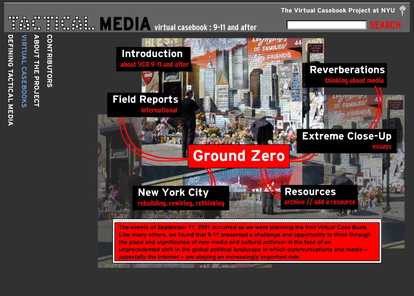

This part of Manhattan, not far from Ground Zero, is our neighbourhood, and during the days that it was cordoned off, it became a pedestrian city, with people claiming the streets. We were an isolated neighbourhood, but also a community that is at the epicenter of global communication.
As the patriotic rhetoric of "war against terrorism" kicked in, and TV became our national grief counselor, the rains came and the City moved to dismantle the shrines, murals, memorial walls, and photographs; at the same time, weblogs and e-mails threatened to disappear. We became aware of just how important small and ephemeral media was, and how little serious media attention (other than a kind of sentimental trivializing that further marginalized it) it was receiving.
To us, it was evidence of the daily lives and spontaneous creative expression of a community responding to crisis; as the raw material of history; as the material of counter-narratives to the official versions; and for what it revealed about the forms and networks of expression took shape in that chaotic time. We also realized that we had colleagues at NYU who look at questions of everyday life, performativity and politics who had begun to look at the same issues. We solicited contributions from them, from students, and from the members of the group who had met in April.
9-11 and after is an experiment, a prototype and still very much in process. It is a gathering of essays, reports, websites, first-person accounts, films and videos that document, frame and analyze the ephemeral material of September 11 and the days immediately after, specifically focusing on Lower Manhattan.
It is a hybrid publication - an interactive reference book that is not only a resource, but a site for research and analysis, and a teaching tool.
9-11 and After Is organized into five main sections:
* Reverberations provides larger perspectives on the unexpected capacities of old and new media.
* Extreme Close-Up documents and contemplates the implications of the effusion of ephemeral material in Lower Manhattan, as people tried to comprehend and communicate.
* Rethinking, Rebuilding, Rewiring demonstrates how New Yorkers used public spaces to rebuild their relationship to the city, in the face of exhortations to "get back to normal." Field Reports offers examples of how people around the world reshaped trajectories of news and information from around the globe
* Resources provides extensive lists of websites, films and videos organized in categories: first-person accounts, news/activism, etc. ? with contextualizing essays.
The virtual case book is, at the same time, an archive and a gathering of archives. For some (see interview with Andrea Vasquez on 911 Digital Archive, www.911digitalarchive.org), it is a depository of suppressed or unnoticed stories, folk art and information--a source of material for historians and for counternarratives. Here is New York (see interview with Charles Traub and www.hereisnewyork.com) combined visual and virtual worlds a website and a public space to which anyone could bring their photographs of the attack and its aftermath, to be digitized and displayed.
* Television Archive (http://tvnews3.televisionarchive.org/tvarchive) gathers 9-11 coverage from 19 television stations available to the public proposing, as Meg McLagan notes in her essay, "Archival Interventions," a digital alternative to copyright.
* www.peoplespoetry.com, was a site to which anyone could submit a poem. True to the recombinant character of digital material, selected lines from this site (and from lines solicited from professional poets) were fashioned into two poems in the shape of the towers, each 110 lines, which became part of Missing: Streetscape of a City in Mourning (see interview with Marci Reaven.) Ted Byfields' Reconstruction Report (http://reconstructionreport.org) is a multi-faceted research and information site that seeks to promote "public understanding of the redevelopment of the WTC site."
These examples only begin to suggest the range of interventions, issues, and opportunities for research and commentary that are embedded in the virtual case book. Our goal is to develop cooperative research projects--with special focus on how the VCB can facilitate teaching. Some possibilities that have been proposed include: the complexities of archiving and evaluating ephemeral material; issues of intellectual and cultural property; and the kinds of social and aesthetic interventions this material represents.
The Virtual Casebook:
www.nyu.edu/fas/projects/vcb/case_911_FLASHcontent.html






